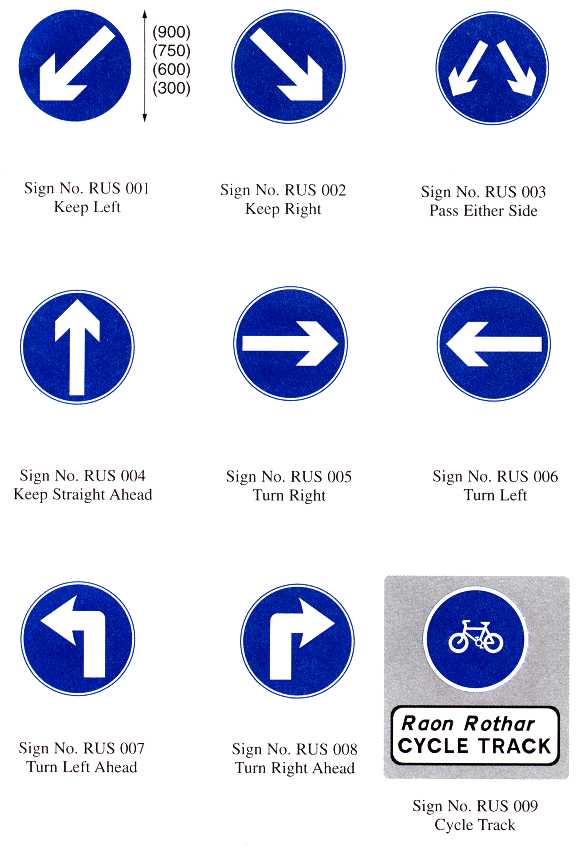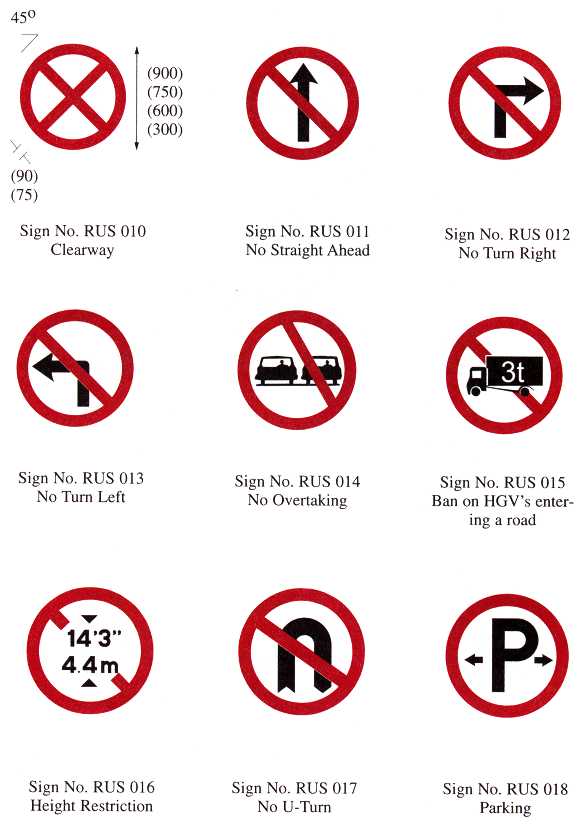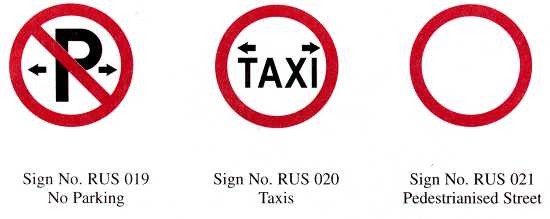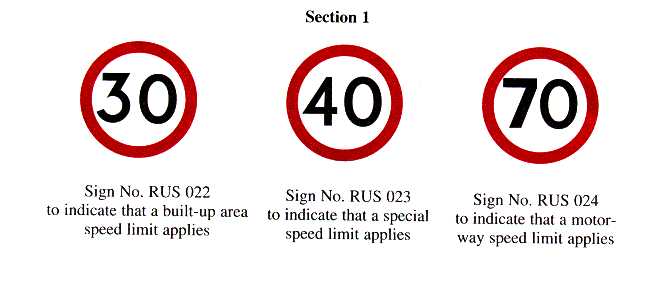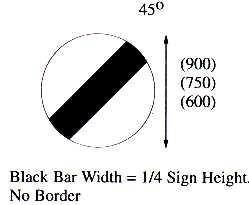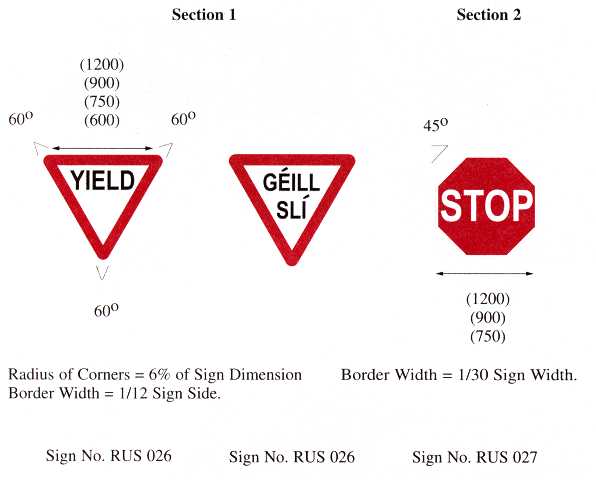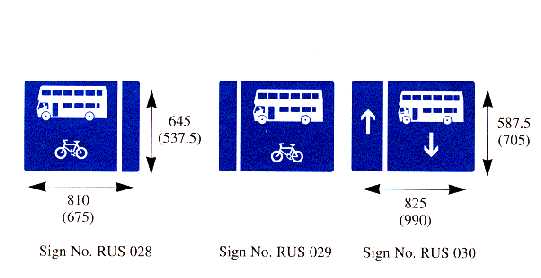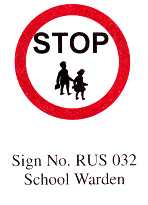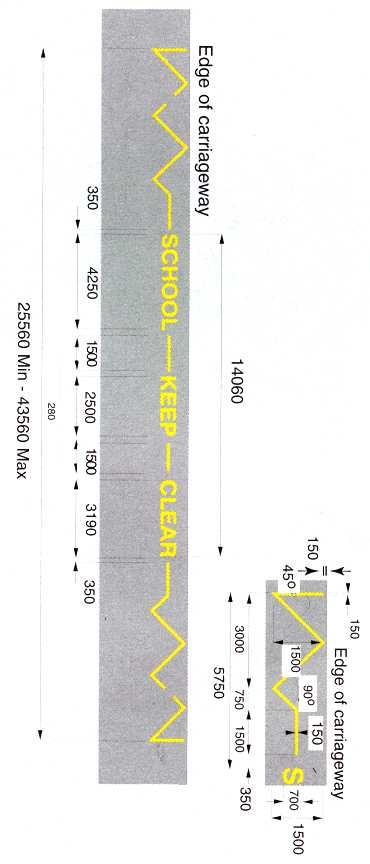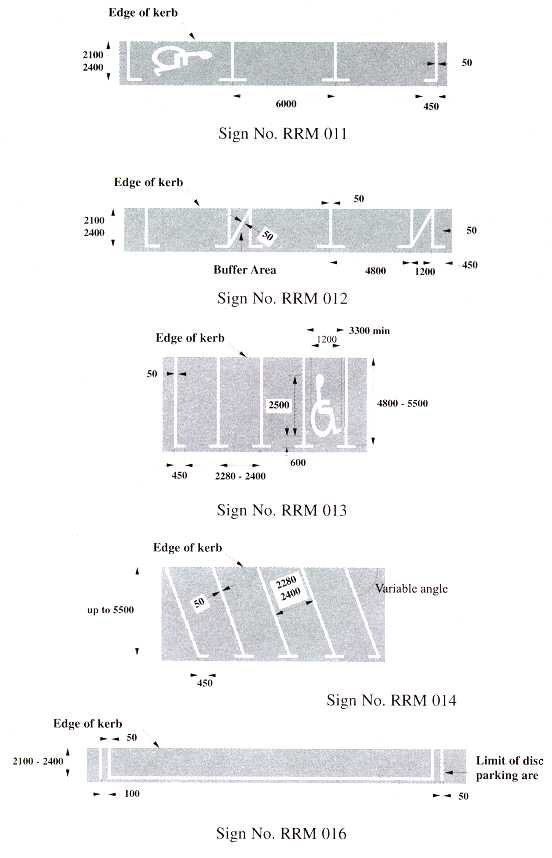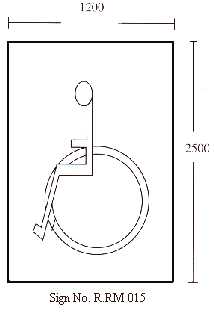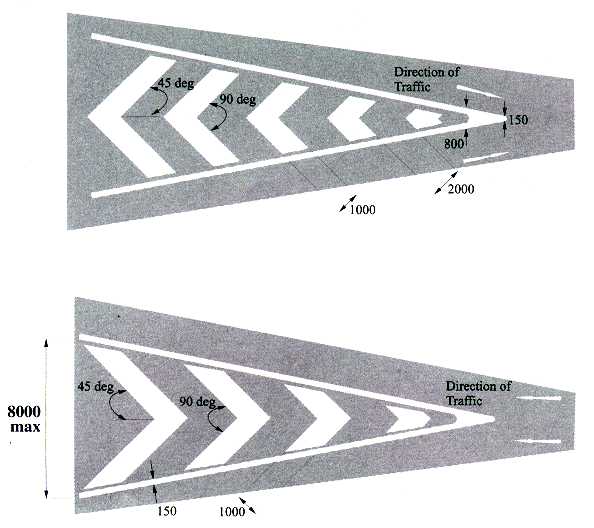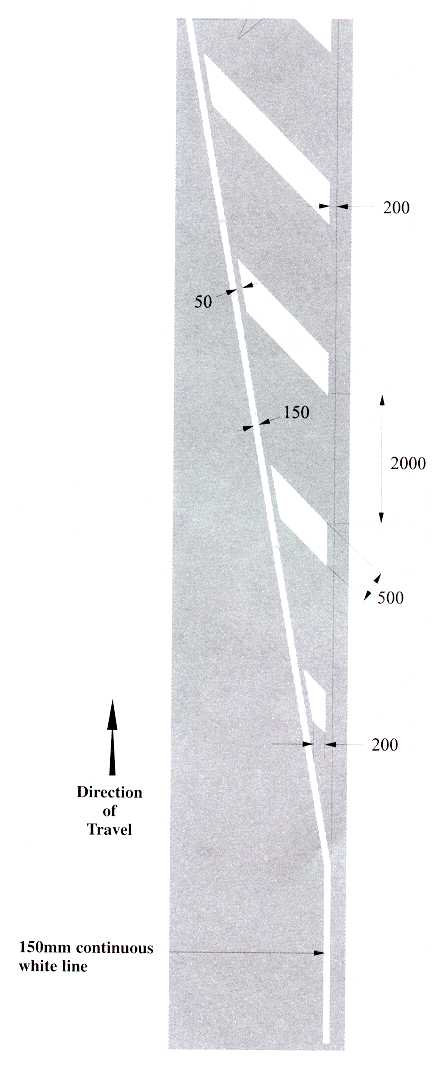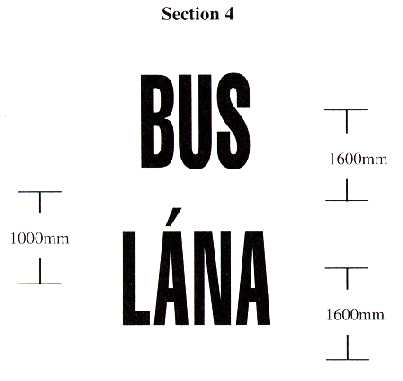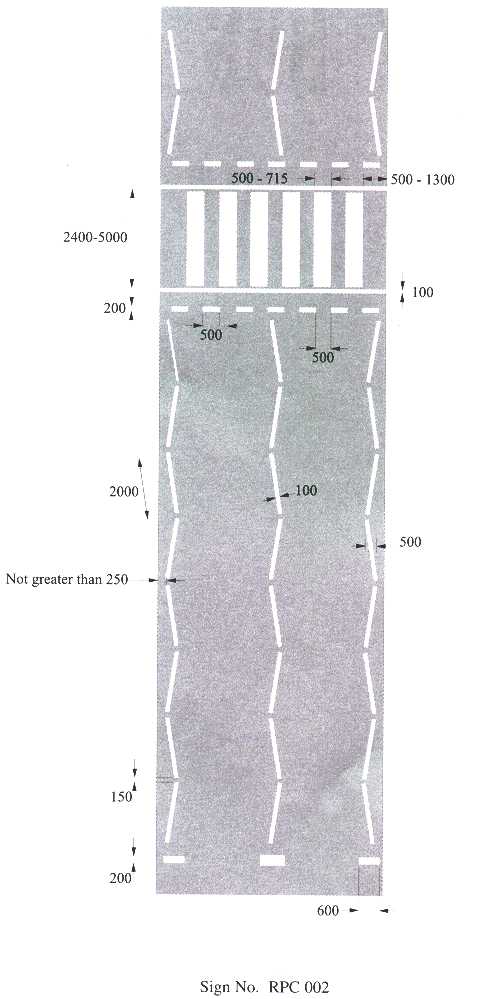S.I. No. 181/1997 - Road Traffic (Signs) Regulations, 1997.
The Minister for the environment, in exercise of the powers vested in him by sections 5 and 86 of the Road Traffic Act, 1961 (No. 24 of 1961), section 95 of the said Act (as amended by section 6 of the Road Traffic Act, 1968 (No. 25 of 1968) and by section 37 of the Road Traffic Act, 1994 (No. 7 of 1994)), and section 96 of the said Act (as amended by section 6 of the Road Traffic Act, 1968 (No. 25 of 1968)) hereby makes the following Regulations:— | ||||||||||||||||||||||||||||||||||||||||||||||||||||||||||||||||||||||||||||||||||||||||||
|
PART I PRELIMINARY AND GENERAL | ||||||||||||||||||||||||||||||||||||||||||||||||||||||||||||||||||||||||||||||||||||||||||
| ||||||||||||||||||||||||||||||||||||||||||||||||||||||||||||||||||||||||||||||||||||||||||
| ||||||||||||||||||||||||||||||||||||||||||||||||||||||||||||||||||||||||||||||||||||||||||
|
1 Short Title. | 1. These Regulations may be cited as the Road Traffic (Signs) Regulations, 1997. | |||||||||||||||||||||||||||||||||||||||||||||||||||||||||||||||||||||||||||||||||||||||||
|
2 Commencement. | 2. These Regulations shall come into operation on 1st day of October, 1997. | |||||||||||||||||||||||||||||||||||||||||||||||||||||||||||||||||||||||||||||||||||||||||
|
3 Interpretation. | 3. (1) In these Regulations:— | |||||||||||||||||||||||||||||||||||||||||||||||||||||||||||||||||||||||||||||||||||||||||
"the Act of 1961" means the Road Traffic Act, 1961 (No. 24 of 1961); | ||||||||||||||||||||||||||||||||||||||||||||||||||||||||||||||||||||||||||||||||||||||||||
"the Act of 1968" means the Road Traffic Act, 1968 (No. 25 of 1968); | ||||||||||||||||||||||||||||||||||||||||||||||||||||||||||||||||||||||||||||||||||||||||||
"the Act of 1994" means the Road Traffic Act, 1994 (No. 7 of 1994); | ||||||||||||||||||||||||||||||||||||||||||||||||||||||||||||||||||||||||||||||||||||||||||
"access" means entry or exit by vehicles to or from premises adjacent to or accessible only from a road and includes stopping a vehicle on a roadway solely for the purposes of loading or unloading goods on to or from such vehicle from or to such premises; | ||||||||||||||||||||||||||||||||||||||||||||||||||||||||||||||||||||||||||||||||||||||||||
"buffer area" means an area between two parking bays; | ||||||||||||||||||||||||||||||||||||||||||||||||||||||||||||||||||||||||||||||||||||||||||
"bus stop sign" means a sign to indicate a stopping place or stand for omnibuses provided under, or in pursuance of, section 86 of the Act of 1961; | ||||||||||||||||||||||||||||||||||||||||||||||||||||||||||||||||||||||||||||||||||||||||||
"cycle track" means a part of a road including part of a footway or part of a roadway which is reserved for the use of pedal cycles and from which all mechanically propelled vehicles other than mechanically propelled wheelchairs are prohibited from entering except for the purpose of access; | ||||||||||||||||||||||||||||||||||||||||||||||||||||||||||||||||||||||||||||||||||||||||||
"design" when used in relation to a sign means the layout of the sign and includes the relative size and position of any symbols, figures, letters, or other markings shown thereon; | ||||||||||||||||||||||||||||||||||||||||||||||||||||||||||||||||||||||||||||||||||||||||||
"disabled persons parking bay'" means a space intended for the parking of a mechanically propelled vehicle in which is displayed a disabled persons parking permit; | ||||||||||||||||||||||||||||||||||||||||||||||||||||||||||||||||||||||||||||||||||||||||||
"disabled persons parking permit" means a permit granted in accordance with Regulations made under section 35 of the Act of 1994; | ||||||||||||||||||||||||||||||||||||||||||||||||||||||||||||||||||||||||||||||||||||||||||
"disc parking place" means a place on a public road where the parking of vehicles is subject to the exhibition of a document in accordance with bye-laws made under section 36 of the Act of 1994; | ||||||||||||||||||||||||||||||||||||||||||||||||||||||||||||||||||||||||||||||||||||||||||
"dual carriageway" means a road, the roadway of which is divided centrally so as to provide two separate carriageways, on each of which traffic is required by a road regulation to proceed in one direction only; | ||||||||||||||||||||||||||||||||||||||||||||||||||||||||||||||||||||||||||||||||||||||||||
"goods vehicle" means a vehicle used exclusively for carrying goods and taxed for commercial purposes; | ||||||||||||||||||||||||||||||||||||||||||||||||||||||||||||||||||||||||||||||||||||||||||
"left" and "right" shall be construed with reference to the direction in which traffic is facing; | ||||||||||||||||||||||||||||||||||||||||||||||||||||||||||||||||||||||||||||||||||||||||||
"loading bay" means that portion of a road indicated by means of a traffic sign on which, at certain times, a vehicle, other than a goods vehicle being used for loading or unloading, shall not be parked; | ||||||||||||||||||||||||||||||||||||||||||||||||||||||||||||||||||||||||||||||||||||||||||
"meter parking place" means a place on a public road where the parking of vehicles is subject to the payment of fees by means of parking meters; | ||||||||||||||||||||||||||||||||||||||||||||||||||||||||||||||||||||||||||||||||||||||||||
"one-way roadway" means a roadway, the traffic on which is for the time being required by a road regulation to proceed in one direction only; | ||||||||||||||||||||||||||||||||||||||||||||||||||||||||||||||||||||||||||||||||||||||||||
"parking bay" means a space in a meter parking place or a disc parking place, or any other place on a public road, intended for the parking of a mechanically propelled vehicle; | ||||||||||||||||||||||||||||||||||||||||||||||||||||||||||||||||||||||||||||||||||||||||||
"pedestrian crossing" means a portion of the roadway specially marked for use by pedestrians crossing the road; | ||||||||||||||||||||||||||||||||||||||||||||||||||||||||||||||||||||||||||||||||||||||||||
"regulatory sign" means a sign which indicates the existence of a road regulation or implements such a regulation, or both, or indicates the existence of a provision in an enactment relating to road traffic; | ||||||||||||||||||||||||||||||||||||||||||||||||||||||||||||||||||||||||||||||||||||||||||
"road" has the meaning assigned to it by section 2 (1) of the Roads Act, 1993 ; | ||||||||||||||||||||||||||||||||||||||||||||||||||||||||||||||||||||||||||||||||||||||||||
"road regulation" has the meaning assigned to it by section 95(1) of the Act of 1961 (as amended by section 37 of the Act of 1994); | ||||||||||||||||||||||||||||||||||||||||||||||||||||||||||||||||||||||||||||||||||||||||||
"roadway markings" means markings placed on the surface of the roadway; | ||||||||||||||||||||||||||||||||||||||||||||||||||||||||||||||||||||||||||||||||||||||||||
"t" appearing on any sign represents one tonne; | ||||||||||||||||||||||||||||||||||||||||||||||||||||||||||||||||||||||||||||||||||||||||||
"traffic" does not include pedestrians; | ||||||||||||||||||||||||||||||||||||||||||||||||||||||||||||||||||||||||||||||||||||||||||
"traffic refuge" means a refuge for pedestrians on a roadway provided by a raised pavement, guard posts or similar means; | ||||||||||||||||||||||||||||||||||||||||||||||||||||||||||||||||||||||||||||||||||||||||||
"traffic sign" has the meaning assigned to it by section 95(1) of the Act of 1961 (as amended by section 37 of the Act of 1994). | ||||||||||||||||||||||||||||||||||||||||||||||||||||||||||||||||||||||||||||||||||||||||||
(2) A reference in these Regulations to an information plate accompanying a traffic sign shall, unless otherwise specified, be to an information plate which shall indicate the period during which the restriction or prohibition indicated by such traffic sign applies. | ||||||||||||||||||||||||||||||||||||||||||||||||||||||||||||||||||||||||||||||||||||||||||
(3) (a) In these Regulations, any reference to an article or Schedule which is not otherwise identified is a reference to an article of, or Schedule to, these Regulations. | ||||||||||||||||||||||||||||||||||||||||||||||||||||||||||||||||||||||||||||||||||||||||||
(b) In these Regulations, any reference to a sub-article, paragraph, or sub-paragraph which is not otherwise identified is a reference to the sub-article, paragraph, or sub-paragraph of the provision in which the reference occurs. | ||||||||||||||||||||||||||||||||||||||||||||||||||||||||||||||||||||||||||||||||||||||||||
|
4 Revocations. | 4. The Regulations specified in the Tenth Schedule are hereby revoked. | |||||||||||||||||||||||||||||||||||||||||||||||||||||||||||||||||||||||||||||||||||||||||
|
PART II REGULATORY SIGN — UPRIGHT | ||||||||||||||||||||||||||||||||||||||||||||||||||||||||||||||||||||||||||||||||||||||||||
| ||||||||||||||||||||||||||||||||||||||||||||||||||||||||||||||||||||||||||||||||||||||||||
| ||||||||||||||||||||||||||||||||||||||||||||||||||||||||||||||||||||||||||||||||||||||||||
|
5 Mandatory Signs. | 5. (1) Subject to sub-article (3), a mandatory traffic sign shall consist of a blue disc with a white border and appropriate symbols shown in white on the disc, and shall indicate | |||||||||||||||||||||||||||||||||||||||||||||||||||||||||||||||||||||||||||||||||||||||||
(a) the direction or route in which traffic must proceed, or | ||||||||||||||||||||||||||||||||||||||||||||||||||||||||||||||||||||||||||||||||||||||||||
(b) a cycle track. | ||||||||||||||||||||||||||||||||||||||||||||||||||||||||||||||||||||||||||||||||||||||||||
(2) The following shall be as set out in the First Schedule:— | ||||||||||||||||||||||||||||||||||||||||||||||||||||||||||||||||||||||||||||||||||||||||||
(a) the dimensions and designs of signs to which this article applies, other than those specified in the Ninth Schedule; | ||||||||||||||||||||||||||||||||||||||||||||||||||||||||||||||||||||||||||||||||||||||||||
(b) the symbols to be used on such signs; | ||||||||||||||||||||||||||||||||||||||||||||||||||||||||||||||||||||||||||||||||||||||||||
(c) the sign numbers applying to such signs. | ||||||||||||||||||||||||||||||||||||||||||||||||||||||||||||||||||||||||||||||||||||||||||
(3) The traffic signs RUS 001A, RUS 004A, RUS 005A, RUS 006A and RUS 009A may be provided, respectively, in lieu of the mandatory traffic sign numbers RUS 00I, RUS 004, RUS 005, RUS 006 and RUS 009 set out in the First Schedule. | ||||||||||||||||||||||||||||||||||||||||||||||||||||||||||||||||||||||||||||||||||||||||||
|
6 Prohibitory Signs. | 6. (1) A prohibitory traffic sign shall consist of a white disc with a red border, appropriate symbols, figures or letters shown in black on the disc, and one or more oblique red bars, and shall indicate any of the following:— | |||||||||||||||||||||||||||||||||||||||||||||||||||||||||||||||||||||||||||||||||||||||||
(a) that a vehicle shall not proceed in the direction indicated in the arrow depicted on the sign; or | ||||||||||||||||||||||||||||||||||||||||||||||||||||||||||||||||||||||||||||||||||||||||||
(b) that a vehicle, or specified type or category of vehicle, shall not enter a road at the entrance to which the traffic sign bas been provided; or | ||||||||||||||||||||||||||||||||||||||||||||||||||||||||||||||||||||||||||||||||||||||||||
(c) that a vehicle, or a specified type or category of vehicle, shall not proceed past a certain point on a road at which the traffic sign has been provided; or | ||||||||||||||||||||||||||||||||||||||||||||||||||||||||||||||||||||||||||||||||||||||||||
(d) that a vehicle, or a specified type or category of vehicle, shall not be parked or stopped in an area, or on a road, or on part of a road, where the traffic sign has been provided. | ||||||||||||||||||||||||||||||||||||||||||||||||||||||||||||||||||||||||||||||||||||||||||
(2) The following shall be as set out in the Second Schedule:— | ||||||||||||||||||||||||||||||||||||||||||||||||||||||||||||||||||||||||||||||||||||||||||
(a) the dimensions and designs at prohibitory traffic signs; | ||||||||||||||||||||||||||||||||||||||||||||||||||||||||||||||||||||||||||||||||||||||||||
(b) the symbols, figures and letters to be used on such signs; | ||||||||||||||||||||||||||||||||||||||||||||||||||||||||||||||||||||||||||||||||||||||||||
(c) the sign numbers applying to such signs. | ||||||||||||||||||||||||||||||||||||||||||||||||||||||||||||||||||||||||||||||||||||||||||
(3) The traffic signs to which this article refers may be accompanied by an information plate as defined in article 3(2) or on an information plate indicating the type or category of vehicle to which the prohibition or restriction applies. | ||||||||||||||||||||||||||||||||||||||||||||||||||||||||||||||||||||||||||||||||||||||||||
(4) Traffic sign numbers RUS 01I, RUS 012 and RUS 013 may be accompanied by a rectangular plate which shall be placed below the sign and on which may be shown in black letters on a white background, the message "Except Buses and Taxis — Ach amháin Busanna agus Tacsaithe", to indicate that the prohibitions indicated by the said signs do not apply in the case of omnibuses and taxis. | ||||||||||||||||||||||||||||||||||||||||||||||||||||||||||||||||||||||||||||||||||||||||||
|
7 Speed Limit Signs. | 7. (1) A speed limit sign other than the sign referred to in sub-article (2) shall consist of a white disc with a red border, and with appropriate figures and letters to indicate the relevant speed limit shown in black on the disc, and shall indicate that the built-up area speed limit, a special speed limit, or the motorway speed limit applies in relation to a road or an area, | |||||||||||||||||||||||||||||||||||||||||||||||||||||||||||||||||||||||||||||||||||||||||
(2) The traffic sign to indicate the commencement of the general speed limit shall consist of a white disc crossed obliquely by a black bar. | ||||||||||||||||||||||||||||||||||||||||||||||||||||||||||||||||||||||||||||||||||||||||||
(3) The following shall be as set out in section 1 of the Third Schedule:— | ||||||||||||||||||||||||||||||||||||||||||||||||||||||||||||||||||||||||||||||||||||||||||
(a) the dimensions and designs of signs to which sub-article (1) applies; | ||||||||||||||||||||||||||||||||||||||||||||||||||||||||||||||||||||||||||||||||||||||||||
(b) the figures and letters to be used an such signs; | ||||||||||||||||||||||||||||||||||||||||||||||||||||||||||||||||||||||||||||||||||||||||||
(c) the sign numbers applying to such signs. | ||||||||||||||||||||||||||||||||||||||||||||||||||||||||||||||||||||||||||||||||||||||||||
(4) The dimensions and design of the sign to which sub article (2) applies and the sign number applying to such sign shall be as set out in section 2 of the Third Schedule. | ||||||||||||||||||||||||||||||||||||||||||||||||||||||||||||||||||||||||||||||||||||||||||
|
8 Yields and Stop Signs. | 8. (1) Traffic sign number RUS 026 shall— | |||||||||||||||||||||||||||||||||||||||||||||||||||||||||||||||||||||||||||||||||||||||||
(a) indicate that traffic shall yield right of way to traffic on a major road ahead; and | ||||||||||||||||||||||||||||||||||||||||||||||||||||||||||||||||||||||||||||||||||||||||||
(b) consist of a red inverted equilateral triangle with rounded corners, the space inside the triangle being coloured white an which shall be shown, in black letters, the words "Yield", "Yield Right of Way', or "Géill SIP'. | ||||||||||||||||||||||||||||||||||||||||||||||||||||||||||||||||||||||||||||||||||||||||||
(2) Traffic sign number RUS 027 shall— | ||||||||||||||||||||||||||||||||||||||||||||||||||||||||||||||||||||||||||||||||||||||||||
(a) indicate that traffic shall stop before entering a major road; and | ||||||||||||||||||||||||||||||||||||||||||||||||||||||||||||||||||||||||||||||||||||||||||
(b) consist of a red octagon with a white border and showing the word "Stop" in white letters. | ||||||||||||||||||||||||||||||||||||||||||||||||||||||||||||||||||||||||||||||||||||||||||
(3) The dimensions and design of the sign to which sub-article (1) applies shall be as set out in section 1 of the Fourth Schedule. | ||||||||||||||||||||||||||||||||||||||||||||||||||||||||||||||||||||||||||||||||||||||||||
(4) The dimensions and design of the sign to which sub-article (2) applies shall be as set out in section 2 of the Fourth Schedule. | ||||||||||||||||||||||||||||||||||||||||||||||||||||||||||||||||||||||||||||||||||||||||||
|
9 Bus Lanes. | 9. (1) Traffic sign number RUS 028 or RUS 029 shall, in association with traffic sign number RRM 023, indicate a bus lane and traffic sign number RUS 030 shall, in association with traffic sign number RRM 023, indicate a contra-flow bus lane. | |||||||||||||||||||||||||||||||||||||||||||||||||||||||||||||||||||||||||||||||||||||||||
(2) Traffic sign numbers RUS 028, RUS 029 and RUS 030 shall consist of a blue rectangle with appropriate symbols or letters shown in white. | ||||||||||||||||||||||||||||||||||||||||||||||||||||||||||||||||||||||||||||||||||||||||||
(3) The content, design and dimensions of traffic sign numbers RUS 028, RUS 029 and RUS 030 shall be as set out in the Fifth Schedule. | ||||||||||||||||||||||||||||||||||||||||||||||||||||||||||||||||||||||||||||||||||||||||||
|
10 School Warden sign. | 10. (1) Traffic sign number RUS 032 shall— | |||||||||||||||||||||||||||||||||||||||||||||||||||||||||||||||||||||||||||||||||||||||||
(a) be exhibited by a school warden to indicate that traffic must stop and remain stopped in accordance with section 96(2) of the Act of 1961 (as amended by section 6 of the Act of 1968), and | ||||||||||||||||||||||||||||||||||||||||||||||||||||||||||||||||||||||||||||||||||||||||||
(b) consist of a white disc, with a red border and the word "Stop" and a symbol signifying children crossing shown in black. | ||||||||||||||||||||||||||||||||||||||||||||||||||||||||||||||||||||||||||||||||||||||||||
(2) The dimensions and design of the sign to which this article refers shall be as set out in the Sixth Schedule. | ||||||||||||||||||||||||||||||||||||||||||||||||||||||||||||||||||||||||||||||||||||||||||
|
PART III ROADWAY MARKINGS | ||||||||||||||||||||||||||||||||||||||||||||||||||||||||||||||||||||||||||||||||||||||||||
| ||||||||||||||||||||||||||||||||||||||||||||||||||||||||||||||||||||||||||||||||||||||||||
| ||||||||||||||||||||||||||||||||||||||||||||||||||||||||||||||||||||||||||||||||||||||||||
|
11 Centre of Roadway . | 11. (1) The following traffic signs may be provided along the centre of a roadway:— | |||||||||||||||||||||||||||||||||||||||||||||||||||||||||||||||||||||||||||||||||||||||||
(a) traffic sign number RRM 001—a continuous white line approximately 100 or 150 millimetres wide and extending not less than 20 metres along the centre of the roadway, or | ||||||||||||||||||||||||||||||||||||||||||||||||||||||||||||||||||||||||||||||||||||||||||
(b) traffic sign number RRM 002 — a broken white line extending along the centre of the roadway and consisting of segments having the following dimensions and spacings:— | ||||||||||||||||||||||||||||||||||||||||||||||||||||||||||||||||||||||||||||||||||||||||||
(i) segments approximately 100 millimetres or 150 millimetres wide, 3 metres and spaced 3 metres apart, or | ||||||||||||||||||||||||||||||||||||||||||||||||||||||||||||||||||||||||||||||||||||||||||
(ii) segments approximately 100 millimetres or 150 millimetres wide, 3 metres long and spaced 9 metres apart. | ||||||||||||||||||||||||||||||||||||||||||||||||||||||||||||||||||||||||||||||||||||||||||
(2) Traffic sign number RRM 001 may be provided along a roadway other than at the centre of the roadway where it is appropriate in accordance with the layout of traffic lanes. | ||||||||||||||||||||||||||||||||||||||||||||||||||||||||||||||||||||||||||||||||||||||||||
|
12 Traffic Lane. | 12. (1) Traffic sign number RRM 003 shall— | |||||||||||||||||||||||||||||||||||||||||||||||||||||||||||||||||||||||||||||||||||||||||
(a) indicate the boundary of a traffic lane, and | ||||||||||||||||||||||||||||||||||||||||||||||||||||||||||||||||||||||||||||||||||||||||||
(b) consist of a broken white line, consisting of segments approximately 100 millimetres or 150 millimetres wide, 2 metres long and 2 metres apart (or 100 millimetres wide, 4 metres long and 8 metres apart on a motorway). | ||||||||||||||||||||||||||||||||||||||||||||||||||||||||||||||||||||||||||||||||||||||||||
|
13 Directions Arrow. | 13. The following traffic signs may be provided on a roadway to indicate the direction or directions in which traffic in a traffic lane must proceed:— | |||||||||||||||||||||||||||||||||||||||||||||||||||||||||||||||||||||||||||||||||||||||||
(i) traffic sign number RRM 004 — a white arrow pointing straight ahead, | ||||||||||||||||||||||||||||||||||||||||||||||||||||||||||||||||||||||||||||||||||||||||||
(ii) traffic sign number RRM 005 — a white arrow pointing or curved to the left, | ||||||||||||||||||||||||||||||||||||||||||||||||||||||||||||||||||||||||||||||||||||||||||
(iii) traffic sign number RRM 006 — a white arrow pointing or curved to the right. | ||||||||||||||||||||||||||||||||||||||||||||||||||||||||||||||||||||||||||||||||||||||||||
|
14 Single Yellow Line. | 14. Traffic sign number RRM 007 shall— | |||||||||||||||||||||||||||||||||||||||||||||||||||||||||||||||||||||||||||||||||||||||||
(a) indicate that parking of vehicles is restricted at certain times on that side of the roadway, and | ||||||||||||||||||||||||||||||||||||||||||||||||||||||||||||||||||||||||||||||||||||||||||
(b) consist of a continuous yellow line approximately 100 millimetres wide extending along the edge of a roadway and situated approximately 300 millimetres from that edge. | ||||||||||||||||||||||||||||||||||||||||||||||||||||||||||||||||||||||||||||||||||||||||||
|
15 Double Yellow Lines | 15. Traffic sign number RRM 008 shall— | |||||||||||||||||||||||||||||||||||||||||||||||||||||||||||||||||||||||||||||||||||||||||
(a) indicate that parking of vehicles is prohibited at any time on that side of the roadway, and | ||||||||||||||||||||||||||||||||||||||||||||||||||||||||||||||||||||||||||||||||||||||||||
(b) consist of two parallel continuous yellow lines approximately 100 millimetres apart extending along the edge of a roadway, each line being approximately 100 millimetres wide, and the line nearest the edge of the roadway being situated approximately 300 millimetres from that edge. | ||||||||||||||||||||||||||||||||||||||||||||||||||||||||||||||||||||||||||||||||||||||||||
|
16 Loading Bay | 16. Traffic sign number RRM 009 shall— | |||||||||||||||||||||||||||||||||||||||||||||||||||||||||||||||||||||||||||||||||||||||||
(a) indicate a loading bay, and | ||||||||||||||||||||||||||||||||||||||||||||||||||||||||||||||||||||||||||||||||||||||||||
(b) consist of the word "LOADING" written in white, once or more than once, accompanied by two end lines, being continuous white lines at right angles to the edge of the roadway, each such line being approximately 100 millimetres wide and extending from the edge of the roadway towards its centre, and broken white lines measuring 450 millimetres in length and 450 millimetres apart, between the word "LOADING" and each of the end lines. | ||||||||||||||||||||||||||||||||||||||||||||||||||||||||||||||||||||||||||||||||||||||||||
|
17 School Entrance. | 17. (1) Traffic sign number RRM 010 shall— | |||||||||||||||||||||||||||||||||||||||||||||||||||||||||||||||||||||||||||||||||||||||||
(a) indicate a school entrance at which part of the roadway, the stopping or parking of a vehicle is prohibited, and | ||||||||||||||||||||||||||||||||||||||||||||||||||||||||||||||||||||||||||||||||||||||||||
(b) consist of the words "SCHOOL KEEP CLEAR", painted on the roadway, on either side of which shall be yellow lines. | ||||||||||||||||||||||||||||||||||||||||||||||||||||||||||||||||||||||||||||||||||||||||||
(2) The dimensions and design of sign number RRM 010 shall be as set out in section 1 of the Seventh Schedule. | ||||||||||||||||||||||||||||||||||||||||||||||||||||||||||||||||||||||||||||||||||||||||||
|
18 Parking Bays. | 18. Traffic sign numbers RRM 01I, RRM 012, RRM 0l3, and RRM 014 shall— | |||||||||||||||||||||||||||||||||||||||||||||||||||||||||||||||||||||||||||||||||||||||||
(a) indicate, in any place on a public road, parking bays, and associated butter areas where provided, and | ||||||||||||||||||||||||||||||||||||||||||||||||||||||||||||||||||||||||||||||||||||||||||
(b) consist of roadway markings, the dimensions and design of which shall be as set out in section 2 of the Seventh Schedule. | ||||||||||||||||||||||||||||||||||||||||||||||||||||||||||||||||||||||||||||||||||||||||||
|
19 Disabled Persons Parking Bay. | 19. Traffic sign number RRM 015 shall— | |||||||||||||||||||||||||||||||||||||||||||||||||||||||||||||||||||||||||||||||||||||||||
(a) indicate a disabled persons parking bay, and | ||||||||||||||||||||||||||||||||||||||||||||||||||||||||||||||||||||||||||||||||||||||||||
(b) consist of roadway markings, the dimensions and design of which shall be as set out in section 2 of the Seventh Schedule. | ||||||||||||||||||||||||||||||||||||||||||||||||||||||||||||||||||||||||||||||||||||||||||
|
20 Disc Parking Area. | 20. (1) Traffic sign number RRM 016 shall indicate a disc parking area. | |||||||||||||||||||||||||||||||||||||||||||||||||||||||||||||||||||||||||||||||||||||||||
(2) The dimensions and design of traffic sign number RRM 016 shall be as set out in the diagram contained in section 2 of the Seventh Schedule. | ||||||||||||||||||||||||||||||||||||||||||||||||||||||||||||||||||||||||||||||||||||||||||
|
21 Stop Line. | 21. Traffic sign number RRM 017 shall— | |||||||||||||||||||||||||||||||||||||||||||||||||||||||||||||||||||||||||||||||||||||||||
(a) indicate the point beyond which traffic shall not proceed when stopping in compliance with a road regulation, and | ||||||||||||||||||||||||||||||||||||||||||||||||||||||||||||||||||||||||||||||||||||||||||
(b) consist of a continuous white line, not less than 200 millimetres and not more than 250 millimetres wide, extending, in the case of a one-way roadway, across the full width of the roadway and, in any other case, across the roadway from the left edge to the centre thereof. | ||||||||||||||||||||||||||||||||||||||||||||||||||||||||||||||||||||||||||||||||||||||||||
|
22 Yield Line. | 22. Traffic sign number RRM 018 shall— | |||||||||||||||||||||||||||||||||||||||||||||||||||||||||||||||||||||||||||||||||||||||||
(a) indicate the point beyond which traffic shall not proceed, where required, in compliance with a road regulation, and | ||||||||||||||||||||||||||||||||||||||||||||||||||||||||||||||||||||||||||||||||||||||||||
(b) consist of a broken white line consisting of segments not less than 200 millimetres and not more than 250 millimetres wide, 500 millimetres long and 500 millimetres apart, or 1 metre long and 1 metre apart, extending, in the case of a one-way roadway, across the full width of the roadway, and, in any other case, across the roadway from the left edge to the centre thereof. | ||||||||||||||||||||||||||||||||||||||||||||||||||||||||||||||||||||||||||||||||||||||||||
|
23 No Entry Line. | 23. Traffic sign number RRM 019 shall— | |||||||||||||||||||||||||||||||||||||||||||||||||||||||||||||||||||||||||||||||||||||||||
(a) indicate that traffic is prohibited from entering the roadway at the entrance to which it is provided, and | ||||||||||||||||||||||||||||||||||||||||||||||||||||||||||||||||||||||||||||||||||||||||||
(b) consist of a continuous white line and a broken white line parallel thereto and approximately 300 millimetres therefrom, extending transversely across the entrance to a roadway, each line being approximately 200 millimetres wide, and the broken line consisting of segments approximately 1 metre long and spaced approximately 1 metre apart. | ||||||||||||||||||||||||||||||||||||||||||||||||||||||||||||||||||||||||||||||||||||||||||
|
24 Box Junction. | 24. Traffic sign number RRM 020 shall— | |||||||||||||||||||||||||||||||||||||||||||||||||||||||||||||||||||||||||||||||||||||||||
(a) indicate an area of roadway which traffic shall not enter except in compliance with a road regulation, and | ||||||||||||||||||||||||||||||||||||||||||||||||||||||||||||||||||||||||||||||||||||||||||
(b) consist of continuous yellow lines approximately 300 millimetres wide enclosing an area of roadway cross-hatched in diagonal yellow lines approximately 200 millimetres wide and approximately 1.4 metres apart. | ||||||||||||||||||||||||||||||||||||||||||||||||||||||||||||||||||||||||||||||||||||||||||
|
25 Merging and Diverging Marking. | 25. (1) Traffic sign number RRM 021 shall indicate an area of roadway into which traffic shall not enter, except in the case of emergency. | |||||||||||||||||||||||||||||||||||||||||||||||||||||||||||||||||||||||||||||||||||||||||
(2) The dimensions and design of the sign to which sub-article (1) refers shall be as set out in either of the diagrams contained in section 3 of the Seventh Schedule, the dimensions being shown in millimetres. | ||||||||||||||||||||||||||||||||||||||||||||||||||||||||||||||||||||||||||||||||||||||||||
|
26 Cycle Track. | 26. (1) Traffic sign number RRM 022 shall— | |||||||||||||||||||||||||||||||||||||||||||||||||||||||||||||||||||||||||||||||||||||||||
(a) indicate the right hand edge of a cycle track where it forms part of a roadway, and | ||||||||||||||||||||||||||||||||||||||||||||||||||||||||||||||||||||||||||||||||||||||||||
(b) consist of a continuous white line approximately 100 millimetres or 150 millimetres wide. | ||||||||||||||||||||||||||||||||||||||||||||||||||||||||||||||||||||||||||||||||||||||||||
(2) Traffic sign number RRM 023 shall— | ||||||||||||||||||||||||||||||||||||||||||||||||||||||||||||||||||||||||||||||||||||||||||
(a) indicate the right and left hand edges of a cycle track where it forms part of a footway, and | ||||||||||||||||||||||||||||||||||||||||||||||||||||||||||||||||||||||||||||||||||||||||||
(b) consist of continuous white lines approximately 100 millimetres or 150 millimetres wide and spaced approximately 1 metre apart. | ||||||||||||||||||||||||||||||||||||||||||||||||||||||||||||||||||||||||||||||||||||||||||
|
27 Bus Lane. | 27. (1) Traffic sign number RRM 024 shall, in association with traffic sign number RUS 028, RUS 029 or RUS 030, indicate a bus lane. | |||||||||||||||||||||||||||||||||||||||||||||||||||||||||||||||||||||||||||||||||||||||||
(2) The sign to which sub-article (1) refers shall consist of— | ||||||||||||||||||||||||||||||||||||||||||||||||||||||||||||||||||||||||||||||||||||||||||
(a) a continuous white line, or lines, 250 millimetres wide, save where one edge of the bus lane coincides with the centre line of a roadway between the bus lane and an adjoining traffic lane; and | ||||||||||||||||||||||||||||||||||||||||||||||||||||||||||||||||||||||||||||||||||||||||||
(b) lettering consisting of the words "BUS LÁNA", the dimensions and design of which shall be as set out in the diagram contained in section 4 of the Seventh Schedule. | ||||||||||||||||||||||||||||||||||||||||||||||||||||||||||||||||||||||||||||||||||||||||||
|
28 Edge of Roadway. | 28. Traffic sign number RRM 025 shall— | |||||||||||||||||||||||||||||||||||||||||||||||||||||||||||||||||||||||||||||||||||||||||
(a) indicate the line of the edge of a roadway, other than a motorway, and | ||||||||||||||||||||||||||||||||||||||||||||||||||||||||||||||||||||||||||||||||||||||||||
(b) consist of a broken yellow line along the edge of a roadway, consisting of segments not less than 100 millimetres and not more than 150 millimetres wide, approximately 2 metres long and approximately 2 metres apart. | ||||||||||||||||||||||||||||||||||||||||||||||||||||||||||||||||||||||||||||||||||||||||||
|
29 Left Edge of Motorway. | 29. Traffic sign number RRM 026 shall— | |||||||||||||||||||||||||||||||||||||||||||||||||||||||||||||||||||||||||||||||||||||||||
(a) indicate the left hand edge of the carriageway of a motorway, and | ||||||||||||||||||||||||||||||||||||||||||||||||||||||||||||||||||||||||||||||||||||||||||
(b) consist of a continuous yellow line approximately 150 millimetres wide. | ||||||||||||||||||||||||||||||||||||||||||||||||||||||||||||||||||||||||||||||||||||||||||
|
30 Right Edge of Motorway. | 30. Traffic sign number RRM 027 shall— | |||||||||||||||||||||||||||||||||||||||||||||||||||||||||||||||||||||||||||||||||||||||||
(a) indicate the right hand edge of the carriageway of a motorway, and | ||||||||||||||||||||||||||||||||||||||||||||||||||||||||||||||||||||||||||||||||||||||||||
(b) consist of a continuous white line approximately 150 millimetres wide. | ||||||||||||||||||||||||||||||||||||||||||||||||||||||||||||||||||||||||||||||||||||||||||
|
31 Access or Exit Lane on Motorway. | 31. Traffic sign number RRM 028 shall— | |||||||||||||||||||||||||||||||||||||||||||||||||||||||||||||||||||||||||||||||||||||||||
(a) indicate the boundary of an access lane or an exit lane on a motorway, and | ||||||||||||||||||||||||||||||||||||||||||||||||||||||||||||||||||||||||||||||||||||||||||
(b) consist of a broken white line consisting of segments approximately 150 millimetres wide, 2 metres long, and spaced approximately 2 metres apart. | ||||||||||||||||||||||||||||||||||||||||||||||||||||||||||||||||||||||||||||||||||||||||||
|
32 Taxi Stand. | 32. Traffic sign number RRM 029 shall— | |||||||||||||||||||||||||||||||||||||||||||||||||||||||||||||||||||||||||||||||||||||||||
(a) indicate a stand for taxis, and | ||||||||||||||||||||||||||||||||||||||||||||||||||||||||||||||||||||||||||||||||||||||||||
(b) consist of the word "TAXIS" in white, once or more than once, accompanied by two end lines, being broken white lines approximately 100 millimetres wide, approximately 600 millimetres long and spaced 600 millimetres apart at right angles to the edge of the roadway and extending towards its centre to a maximum distance of 2.4 metres, and with broken white lines measuring approximately 600 millimetres long and 600 millimetres apart between the word "TAXIS" and each of the end lines. | ||||||||||||||||||||||||||||||||||||||||||||||||||||||||||||||||||||||||||||||||||||||||||
|
PART IV TRAFFIC SIGNALS | ||||||||||||||||||||||||||||||||||||||||||||||||||||||||||||||||||||||||||||||||||||||||||
| ||||||||||||||||||||||||||||||||||||||||||||||||||||||||||||||||||||||||||||||||||||||||||
| ||||||||||||||||||||||||||||||||||||||||||||||||||||||||||||||||||||||||||||||||||||||||||
|
33 Traffic Lights. | 33. Traffic sign number RTS 001 shall consist of a set of three lamps which shall comply with the following conditions: | |||||||||||||||||||||||||||||||||||||||||||||||||||||||||||||||||||||||||||||||||||||||||
(i) the lamps shall face the stream of traffic they are intended to control; | ||||||||||||||||||||||||||||||||||||||||||||||||||||||||||||||||||||||||||||||||||||||||||
(ii) the lamps shall show red, amber (which may be flashing or non-flashing) and green lights respectively when lit; | ||||||||||||||||||||||||||||||||||||||||||||||||||||||||||||||||||||||||||||||||||||||||||
(iii) the lamps shall be arranged vertically, the red light being uppermost and the green light being lowest; | ||||||||||||||||||||||||||||||||||||||||||||||||||||||||||||||||||||||||||||||||||||||||||
(iv) each lamp shall be separately illuminated and the effective diameter of the lens thereof shall be either between 200 millimetres and 215 millimetres or between 300 millimetres and 315 millimetres; | ||||||||||||||||||||||||||||||||||||||||||||||||||||||||||||||||||||||||||||||||||||||||||
(v) the centre of the lens of a lamp shall be not more than 380 millimetres from that of the lamp immediately next to it; | ||||||||||||||||||||||||||||||||||||||||||||||||||||||||||||||||||||||||||||||||||||||||||
(vi) each lamp shall be lighted and extinguished in turn, at intervals determined by an automatic or manually operated device; | ||||||||||||||||||||||||||||||||||||||||||||||||||||||||||||||||||||||||||||||||||||||||||
(vii) the lower edge of the lowest lamp shall be not less than 2.1 metres and not more than 3.05 metres above the surface of the ground in the immediate vicinity. | ||||||||||||||||||||||||||||||||||||||||||||||||||||||||||||||||||||||||||||||||||||||||||
|
34 .. | 34. Traffic sign number RTS 002 shall consist of a set of three lamps which shall comply with the conditions set out in article 33, save that a lamp showing, when lit, a green arrow on a black field shall be substituted for the lamp showing a green light when lit. | |||||||||||||||||||||||||||||||||||||||||||||||||||||||||||||||||||||||||||||||||||||||||
|
35 .. | 35. Traffic sign number RTS 003 shall consist of a set of four lamps, three of which shall comply with the conditions in either article 33 or article 34, and the fourth of which shall— | |||||||||||||||||||||||||||||||||||||||||||||||||||||||||||||||||||||||||||||||||||||||||
(i) comply with conditions (i), (iv), (v), and (vi) set out in article 33; | ||||||||||||||||||||||||||||||||||||||||||||||||||||||||||||||||||||||||||||||||||||||||||
(ii) be placed beside the lowest lamp referred to in article 33 or article 34; and | ||||||||||||||||||||||||||||||||||||||||||||||||||||||||||||||||||||||||||||||||||||||||||
(iii) show, when lit, a green arrow on a black field. | ||||||||||||||||||||||||||||||||||||||||||||||||||||||||||||||||||||||||||||||||||||||||||
|
36 .. | 36. Traffic sign. number RTS 004 shall consist of a set of three lamps which shall comply with conditions (i), (iv), (vi), and (vii) set out in article 33 and with the following conditions: | |||||||||||||||||||||||||||||||||||||||||||||||||||||||||||||||||||||||||||||||||||||||||
(i) the lamps shall show red, amber, and flashing amber lights, respectively, when lit; and | ||||||||||||||||||||||||||||||||||||||||||||||||||||||||||||||||||||||||||||||||||||||||||
(ii) the lamps shall be arranged vertically, that showing a red light when lit being uppermost and that showing a flashing amber light when lit being lowest. | ||||||||||||||||||||||||||||||||||||||||||||||||||||||||||||||||||||||||||||||||||||||||||
|
37 Level Crossings. | 37. (1) Traffic sign number RTS 005 shall be used to control traffic and pedestrians at railway level crossings. | |||||||||||||||||||||||||||||||||||||||||||||||||||||||||||||||||||||||||||||||||||||||||
(2) The sign to which sub-article (1) refers shall consist of a set of three lamps, two of which shall be red and one amber, facing the stream of traffic they are intended to control, which shall comply with the following conditions: | ||||||||||||||||||||||||||||||||||||||||||||||||||||||||||||||||||||||||||||||||||||||||||
(i) each of the lamps shall illuminate separately and have a diameter of between 200 millimetres and 215 millimetres or 300 millimetres and 315 millimetres; | ||||||||||||||||||||||||||||||||||||||||||||||||||||||||||||||||||||||||||||||||||||||||||
(ii) the lamps showing an amber light shall be centrally positioned and, when lit, shall remain constant; | ||||||||||||||||||||||||||||||||||||||||||||||||||||||||||||||||||||||||||||||||||||||||||
(iii) the lamps showing red lights shall be positioned above and to the side of the lamp showing an amber light, and, when lit, will flash alternately in such a way that one lamp is always illuminated when the lamps are in operation. | ||||||||||||||||||||||||||||||||||||||||||||||||||||||||||||||||||||||||||||||||||||||||||
(3) The alternately flashing red lamps referred to in sub-article (2) shall signify that the stream of traffic controlled by such signal must not proceed beyond traffic sign number RRM 017 [stop line] on the roadway at the signal' or beyond the signal if traffic sign number RRM 017 is not provided. | ||||||||||||||||||||||||||||||||||||||||||||||||||||||||||||||||||||||||||||||||||||||||||
(4) The illumination of the amber light referred to in sub-article (2) shall signify that only that portion of the stream of traffic controlled by such signal that is too close to traffic sign number RRM 017 at such signal (or to the signal if traffic sign number RRM 017 is not provided) when the amber light illuminates that it cannot safely stop before entering the railway level crossing may proceed past such signal or sign. | ||||||||||||||||||||||||||||||||||||||||||||||||||||||||||||||||||||||||||||||||||||||||||
(5) The traffic sign to which sub-article (1) refers may be accompanied by a rectangular or square plate or plates on which there may be shown, in black lettering on a white background, details of special precautions to be taken by certain classes of road users prior to entering the crossing. | ||||||||||||||||||||||||||||||||||||||||||||||||||||||||||||||||||||||||||||||||||||||||||
|
PART V PEDESTRIAN CROSSINGS | ||||||||||||||||||||||||||||||||||||||||||||||||||||||||||||||||||||||||||||||||||||||||||
| ||||||||||||||||||||||||||||||||||||||||||||||||||||||||||||||||||||||||||||||||||||||||||
| ||||||||||||||||||||||||||||||||||||||||||||||||||||||||||||||||||||||||||||||||||||||||||
|
38 .. | 38. (1) Traffic sign number RPC 001 shall indicate a pedestrian crossing. | |||||||||||||||||||||||||||||||||||||||||||||||||||||||||||||||||||||||||||||||||||||||||
(2) The traffic sign to which sub-article (1) refers shall consist of the following: | ||||||||||||||||||||||||||||||||||||||||||||||||||||||||||||||||||||||||||||||||||||||||||
(a) roadway markings consisting of two parallel continuous white lines, each approximately 100 millimetres wide, not less than 2 metres and not more than 6 metres apart, extending where there is no traffic refuge at the crossing, across the full width of the road, and where there is a traffic refuge at the crossing, from the edge of each side of the roadway to the nearer limit of the traffic refuge; | ||||||||||||||||||||||||||||||||||||||||||||||||||||||||||||||||||||||||||||||||||||||||||
(b) a beacon at or near each end of the crossing and, where there is a traffic refuge at the crossing, a beacon on the traffic refuge, each beacon emitting, save as is provided in sub-article (3) at regular intervals flashes of yellow light at the rate of not more than forty-five and not less than thirty-five flashes a minute; and | ||||||||||||||||||||||||||||||||||||||||||||||||||||||||||||||||||||||||||||||||||||||||||
(c) roadway markings consisting of alternate black and white stripes drawn parallel to the line of the roadway within the limits of the roadway markings described in paragraph (a) and extending longitudinally to within approximately 100 millimetres of each of the said markings, each stripe being not less than 500 millimetres and not more than 715 millimetres wide except the stripe at the edge of each side of the roadway which shall be not less than 500 millimetres and not more than 1.3 metres wide and shall be black in colour. | ||||||||||||||||||||||||||||||||||||||||||||||||||||||||||||||||||||||||||||||||||||||||||
(3) The requirement that each beacon at a pedestrian crossing shall emit a flashing light shall not apply in respect of a crossing at which, for the time being, one and only one of the beacons has failed so to light. | ||||||||||||||||||||||||||||||||||||||||||||||||||||||||||||||||||||||||||||||||||||||||||
(4) In this article; "beacon" means a spherical globe which is yellow in colour and approximately 300 millimetres in diameter, and is mounted not less than 2.1 metres and not more than 4.2 metres above the surface of the ground in the immediate vicinity. | ||||||||||||||||||||||||||||||||||||||||||||||||||||||||||||||||||||||||||||||||||||||||||
|
39 Pedestrian Crossing Complex. | 39. Traffic sign number RPC 002 shall consist of roadway markings associated with traffic sign number RPC 001 referred to in article 38 together with a pattern of white lines at each side of such markings, the dimensions and design of which shall be as set out in the Eighth Schedule. | |||||||||||||||||||||||||||||||||||||||||||||||||||||||||||||||||||||||||||||||||||||||||
|
40 Pedestrian Crossing Signals. | 40. (1) Traffic sign numbers RPC 003 and RPC 004 shall, by mechanical signals, control the crossing of a road by pedestrians. | |||||||||||||||||||||||||||||||||||||||||||||||||||||||||||||||||||||||||||||||||||||||||
(2) Traffic sign number RPC 003 shall consist of a set of two lamps, which shall comply with the following conditions: | ||||||||||||||||||||||||||||||||||||||||||||||||||||||||||||||||||||||||||||||||||||||||||
(i) it shall face the pedestrians whose movements it is intended to control; | ||||||||||||||||||||||||||||||||||||||||||||||||||||||||||||||||||||||||||||||||||||||||||
(ii) one lamp shall show, when lit— | ||||||||||||||||||||||||||||||||||||||||||||||||||||||||||||||||||||||||||||||||||||||||||
(a) a green light through the full area of the lens, or, | ||||||||||||||||||||||||||||||||||||||||||||||||||||||||||||||||||||||||||||||||||||||||||
(b) a figure of a pedestrian in green on a black background, or, | ||||||||||||||||||||||||||||||||||||||||||||||||||||||||||||||||||||||||||||||||||||||||||
(c) a message (such as the words "CROSS NOW") in white on a black background, | ||||||||||||||||||||||||||||||||||||||||||||||||||||||||||||||||||||||||||||||||||||||||||
indicating that pedestrians may cross the road; | ||||||||||||||||||||||||||||||||||||||||||||||||||||||||||||||||||||||||||||||||||||||||||
(iii) the lamp referred to in paragraph (ii)(b) may be illuminated on an intermittent basis to indicate that pedestrians already in the course of crossing the road may continue to do so, but, otherwise, pedestrians shall not cross the road; | ||||||||||||||||||||||||||||||||||||||||||||||||||||||||||||||||||||||||||||||||||||||||||
(iv) the other lamp shall show, when lit— | ||||||||||||||||||||||||||||||||||||||||||||||||||||||||||||||||||||||||||||||||||||||||||
(a) a red light through the full area of the lens (which may contain in black letters a message such as the word "WAIT"), or | ||||||||||||||||||||||||||||||||||||||||||||||||||||||||||||||||||||||||||||||||||||||||||
(b) a figure of a pedestrian in red on a black background, | ||||||||||||||||||||||||||||||||||||||||||||||||||||||||||||||||||||||||||||||||||||||||||
indicating that pedestrians shall not cross the road; | ||||||||||||||||||||||||||||||||||||||||||||||||||||||||||||||||||||||||||||||||||||||||||
(v) the lamps shall be arranged vertically, that showing a red light, when lit, being placed above the other; | ||||||||||||||||||||||||||||||||||||||||||||||||||||||||||||||||||||||||||||||||||||||||||
(vi) each lamp shall be separately illuminated, and the diameter of the lens thereof shall be between 200 millimetres and 215 millimetres; | ||||||||||||||||||||||||||||||||||||||||||||||||||||||||||||||||||||||||||||||||||||||||||
(vii) the centres of the lenses of the lamps shall be not more than 700 millimetres apart; | ||||||||||||||||||||||||||||||||||||||||||||||||||||||||||||||||||||||||||||||||||||||||||
(viii) each lamp shall be lighted and extinguished in turn, at intervals determined by an automatic or manually operated device; | ||||||||||||||||||||||||||||||||||||||||||||||||||||||||||||||||||||||||||||||||||||||||||
(ix) the lower edge of the lower lamp shall be not less than 2.1 metres and not more than 3.05 metres above the surface of the ground in the immediate vicinity. | ||||||||||||||||||||||||||||||||||||||||||||||||||||||||||||||||||||||||||||||||||||||||||
(3) Traffic sign number RPC 004 shall consist of a set of three lamps which shall comply with conditions (i), (vi), (vii), and (viii) of sub-article (2) and with the following conditions: — | ||||||||||||||||||||||||||||||||||||||||||||||||||||||||||||||||||||||||||||||||||||||||||
(i) one lamp, when lit, shall show a figure of a standing person in green on a black background, indicating that pedestrians may cross the road; | ||||||||||||||||||||||||||||||||||||||||||||||||||||||||||||||||||||||||||||||||||||||||||
(ii) a second lamp, when lit, shall show a figure of a standing person in amber on a black background, indicating that pedestrians may not cross the road unless they had commenced to do so while the lamp described in paragraph (i) was lit; | ||||||||||||||||||||||||||||||||||||||||||||||||||||||||||||||||||||||||||||||||||||||||||
(iii) a third lamp, when lit, shall show a figure of a standing person in red on a black background, indicating that pedestrians shall not cross the road; | ||||||||||||||||||||||||||||||||||||||||||||||||||||||||||||||||||||||||||||||||||||||||||
(iv) the lamps shall be arranged vertically, that showing a red light, when lit, being uppermost, and that showing a green light, when lit, being lowest; | ||||||||||||||||||||||||||||||||||||||||||||||||||||||||||||||||||||||||||||||||||||||||||
(v) the lower edge of the lowest lamp shall be not less than 2.1 metres and not more than 3.05 metres above the surface of the ground in the immediate vicinity. | ||||||||||||||||||||||||||||||||||||||||||||||||||||||||||||||||||||||||||||||||||||||||||
|
PART VI SIGNS AND MARKINGS FOR BUS STOPS | ||||||||||||||||||||||||||||||||||||||||||||||||||||||||||||||||||||||||||||||||||||||||||
| ||||||||||||||||||||||||||||||||||||||||||||||||||||||||||||||||||||||||||||||||||||||||||
| ||||||||||||||||||||||||||||||||||||||||||||||||||||||||||||||||||||||||||||||||||||||||||
|
41 Bus Stop Sign. | 41. (1) Traffic sign number RUS 031 shall indicate a stopping place or stand for omnibuses provided under, or in pursuance of, section 86 of the Act of 1961. | |||||||||||||||||||||||||||||||||||||||||||||||||||||||||||||||||||||||||||||||||||||||||
(2) The sign to which sub-article (1) refers shall— | ||||||||||||||||||||||||||||||||||||||||||||||||||||||||||||||||||||||||||||||||||||||||||
(i) be rectangular in shape with rounded corners and shall be not more than 450 mill metres and not less than 350 millimetres wide an not more than 300 millimetres and not less than 200 millimetres in height, or | ||||||||||||||||||||||||||||||||||||||||||||||||||||||||||||||||||||||||||||||||||||||||||
(ii) be circular in shape and shall be n t less than 350 millimetres and not more than 4 0 millimetres in diameter, | ||||||||||||||||||||||||||||||||||||||||||||||||||||||||||||||||||||||||||||||||||||||||||
and shall show the word "BUS" in a light c lour on a dark background. | ||||||||||||||||||||||||||||||||||||||||||||||||||||||||||||||||||||||||||||||||||||||||||
|
42 Bus Stop Markings. | 42. (1) Subject to sub-article (2), the following are the approved size, form and colour of traffic sign number RRM 030 provided under or in pursuance of section 86 of the Act of 1961 to indicate the area at a stopping place or stand for omnibuses within which vehicles (other than vehicles for which the stopping place or stand is directed under section 85 of the Act of 1961) are not to be stopped or parked:— | |||||||||||||||||||||||||||||||||||||||||||||||||||||||||||||||||||||||||||||||||||||||||
(a) two end-lines, being continuous white lines at right angles to the kerb, each such line being approximately 100 millimetres wide and extending for a distance of approximately 3 metres outwards from the kerb, and | ||||||||||||||||||||||||||||||||||||||||||||||||||||||||||||||||||||||||||||||||||||||||||
(b) a longitudinal broken white line, which shall be as follows:— | ||||||||||||||||||||||||||||||||||||||||||||||||||||||||||||||||||||||||||||||||||||||||||
(i) it shall connect the outer extremities of the two end-lines; | ||||||||||||||||||||||||||||||||||||||||||||||||||||||||||||||||||||||||||||||||||||||||||
(ii) it shall consist of segments approximately 100 millimetres wide, 1 metre long, and 1 metre apart; | ||||||||||||||||||||||||||||||||||||||||||||||||||||||||||||||||||||||||||||||||||||||||||
(iii) in the case of a stopping place directed for one omnibus route only, it shall extend for a distance not exceeding 41 metres; | ||||||||||||||||||||||||||||||||||||||||||||||||||||||||||||||||||||||||||||||||||||||||||
(iv) in the case of a stopping place directed for more than one omnibus route and, in the case of a stand, it shall extend for a distance not exceeding 60 metres. | ||||||||||||||||||||||||||||||||||||||||||||||||||||||||||||||||||||||||||||||||||||||||||
(2) Where the distance between two or more nearby bus stop signs is such that contiguous or overlapping spaces would be marked if the provisions of sub-article (1) were complied with, one set of roadway markings shall be used instead, consisting of: | ||||||||||||||||||||||||||||||||||||||||||||||||||||||||||||||||||||||||||||||||||||||||||
(a) two end-lines as prescribed by sub-article (1) and | ||||||||||||||||||||||||||||||||||||||||||||||||||||||||||||||||||||||||||||||||||||||||||
(b) a longitudinal broken line, complying except as to length, with sub-article (1). | ||||||||||||||||||||||||||||||||||||||||||||||||||||||||||||||||||||||||||||||||||||||||||
|
PART VII PORTABLE TRAFFIC SIGNS FOR THE CONTROL OF TRAFFIC BY THE GARDA SÍOCHÁNA UNDER SECTION 9I OF THE ACT OF 1961 | ||||||||||||||||||||||||||||||||||||||||||||||||||||||||||||||||||||||||||||||||||||||||||
| ||||||||||||||||||||||||||||||||||||||||||||||||||||||||||||||||||||||||||||||||||||||||||
| ||||||||||||||||||||||||||||||||||||||||||||||||||||||||||||||||||||||||||||||||||||||||||
|
43 Portable Signs for use by Gardaí | 43. The portable signs to be used by the Garda Síochána in exercise of the powers conferred on them by section 91 of the Act of 1961 shall be— | |||||||||||||||||||||||||||||||||||||||||||||||||||||||||||||||||||||||||||||||||||||||||
(a) all of the traffic signs set out in the First Schedule and the Ninth Schedule, except traffic sign numbers RUS 009 and RUS 009A; and | ||||||||||||||||||||||||||||||||||||||||||||||||||||||||||||||||||||||||||||||||||||||||||
(b) traffic sign numbers RUS 01I, RUS 012, RUS 013, RUS 018, RUS 019, | ||||||||||||||||||||||||||||||||||||||||||||||||||||||||||||||||||||||||||||||||||||||||||
save that the dimensions of the signs may be reduced but so that the diameter of the sign shall not be less than 175 millimetres. | ||||||||||||||||||||||||||||||||||||||||||||||||||||||||||||||||||||||||||||||||||||||||||
|
PART VIII SCHOOL WARDENS UNIFORM | ||||||||||||||||||||||||||||||||||||||||||||||||||||||||||||||||||||||||||||||||||||||||||
| ||||||||||||||||||||||||||||||||||||||||||||||||||||||||||||||||||||||||||||||||||||||||||
| ||||||||||||||||||||||||||||||||||||||||||||||||||||||||||||||||||||||||||||||||||||||||||
|
44 School Wardens Uniform. | 44. The uniform to be worn by a school warden exercising powers under section 96(2) of the Act of 1961 (as amended by section 6 of the Act of 1968), shall consist of a hat and an overcoat and shall include material which is retroreflective. | |||||||||||||||||||||||||||||||||||||||||||||||||||||||||||||||||||||||||||||||||||||||||
|
FIRST SCHEDULE | ||||||||||||||||||||||||||||||||||||||||||||||||||||||||||||||||||||||||||||||||||||||||||
Mandatory Traffic Signs | ||||||||||||||||||||||||||||||||||||||||||||||||||||||||||||||||||||||||||||||||||||||||||
| ||||||||||||||||||||||||||||||||||||||||||||||||||||||||||||||||||||||||||||||||||||||||||
Note: | ||||||||||||||||||||||||||||||||||||||||||||||||||||||||||||||||||||||||||||||||||||||||||
The dimensions shown for traffic sign number RUS 001 are in millimeters, and these dimensions shall apply also to all of the other traffic signs set out in this Schedule | ||||||||||||||||||||||||||||||||||||||||||||||||||||||||||||||||||||||||||||||||||||||||||
|
SECOND SCHEDULE | ||||||||||||||||||||||||||||||||||||||||||||||||||||||||||||||||||||||||||||||||||||||||||
Prohibitory Traffic Signs | ||||||||||||||||||||||||||||||||||||||||||||||||||||||||||||||||||||||||||||||||||||||||||
| ||||||||||||||||||||||||||||||||||||||||||||||||||||||||||||||||||||||||||||||||||||||||||
| ||||||||||||||||||||||||||||||||||||||||||||||||||||||||||||||||||||||||||||||||||||||||||
Note: | ||||||||||||||||||||||||||||||||||||||||||||||||||||||||||||||||||||||||||||||||||||||||||
1. The dimensions shown for traffic sign number RUS 010 are in millimeters, and these dimensions shall apply also to all of the other traffic signs set out in this Schedule. | ||||||||||||||||||||||||||||||||||||||||||||||||||||||||||||||||||||||||||||||||||||||||||
2. In the cases of traffic sign numbers RUS 018, RUS 019, and RUS 020, either or both of the arrows may be omitted. | ||||||||||||||||||||||||||||||||||||||||||||||||||||||||||||||||||||||||||||||||||||||||||
3. Traffic sign number RUS 019 placed on, or affixed to, a parking meter at a parking bay may be used to indicate that parking is prohibited in that parking bay, and the dimensions of the sign may be reduced but so that the diameter of the sign shall not be less than 150 millimeters. | ||||||||||||||||||||||||||||||||||||||||||||||||||||||||||||||||||||||||||||||||||||||||||
|
THIRD SCHEDULE | ||||||||||||||||||||||||||||||||||||||||||||||||||||||||||||||||||||||||||||||||||||||||||
Speed Limit Signs | ||||||||||||||||||||||||||||||||||||||||||||||||||||||||||||||||||||||||||||||||||||||||||
Section 1 | ||||||||||||||||||||||||||||||||||||||||||||||||||||||||||||||||||||||||||||||||||||||||||
| ||||||||||||||||||||||||||||||||||||||||||||||||||||||||||||||||||||||||||||||||||||||||||
Section 2 | ||||||||||||||||||||||||||||||||||||||||||||||||||||||||||||||||||||||||||||||||||||||||||
| ||||||||||||||||||||||||||||||||||||||||||||||||||||||||||||||||||||||||||||||||||||||||||
Sign No. RUS 025 | ||||||||||||||||||||||||||||||||||||||||||||||||||||||||||||||||||||||||||||||||||||||||||
to indicate the commencement of a general speed limit | ||||||||||||||||||||||||||||||||||||||||||||||||||||||||||||||||||||||||||||||||||||||||||
Note: | ||||||||||||||||||||||||||||||||||||||||||||||||||||||||||||||||||||||||||||||||||||||||||
1. The dimensions shown for traffic sign number RUS 010 in the Second Schedule shall apply also to the signs shown in section I of this Schedule. | ||||||||||||||||||||||||||||||||||||||||||||||||||||||||||||||||||||||||||||||||||||||||||
2. Where traffic sign number RUS 023 is used to indicate that a special speed limit other than one of 40 miles per hour, the speed prescribed by the special speed limit shall be shown on the sign instead of "40" in the same way as the figure "40" is shown in the diagram for the sign. | ||||||||||||||||||||||||||||||||||||||||||||||||||||||||||||||||||||||||||||||||||||||||||
3. Where it is desired to repeat the sign along the length of road to which the speed limit applies, the dimensions of the sign may be reduced by one-half. | ||||||||||||||||||||||||||||||||||||||||||||||||||||||||||||||||||||||||||||||||||||||||||
4. Where in the opinion of the road authority providing traffic sign No. RUS 025 it is desirable to provide the sign in a reduced size, the dimension of the sign may be reduced by three-eighths. | ||||||||||||||||||||||||||||||||||||||||||||||||||||||||||||||||||||||||||||||||||||||||||
|
FOURTH SCHEDULE | ||||||||||||||||||||||||||||||||||||||||||||||||||||||||||||||||||||||||||||||||||||||||||
Yield and Stop Signs | ||||||||||||||||||||||||||||||||||||||||||||||||||||||||||||||||||||||||||||||||||||||||||
| ||||||||||||||||||||||||||||||||||||||||||||||||||||||||||||||||||||||||||||||||||||||||||
Note: | ||||||||||||||||||||||||||||||||||||||||||||||||||||||||||||||||||||||||||||||||||||||||||
1. The height of the letters in signs RUS 026 shall be 100 mm; the radius of corners shall be 6% of the sign dimension; and the border width shall be one-tenth of the sign height. | ||||||||||||||||||||||||||||||||||||||||||||||||||||||||||||||||||||||||||||||||||||||||||
2. The dimensions of the alternative Irish language version of sign number RUS 026 shall be the same as those applying to the English language version. | ||||||||||||||||||||||||||||||||||||||||||||||||||||||||||||||||||||||||||||||||||||||||||
3. Where in the opinion of the road authority providing sign RUS 026 it is desirable to provide the sign in a reduced or increased size, the dimensions of the sign may be reduced by 20% or increased by a maximum of 60%, as appropriate. | ||||||||||||||||||||||||||||||||||||||||||||||||||||||||||||||||||||||||||||||||||||||||||
4. The words "Right of Way" may be added to the word "Yield" in traffic sign No. RUS 026. | ||||||||||||||||||||||||||||||||||||||||||||||||||||||||||||||||||||||||||||||||||||||||||
5. The border width of sign No. RUS 027 shall be one-tenth of the sign height. | ||||||||||||||||||||||||||||||||||||||||||||||||||||||||||||||||||||||||||||||||||||||||||
|
FIFTH SCHEDULE | ||||||||||||||||||||||||||||||||||||||||||||||||||||||||||||||||||||||||||||||||||||||||||
| ||||||||||||||||||||||||||||||||||||||||||||||||||||||||||||||||||||||||||||||||||||||||||
Note: | ||||||||||||||||||||||||||||||||||||||||||||||||||||||||||||||||||||||||||||||||||||||||||
1. The dimension shown for traffic sign Nos. RUS 028 and RUS 030 are in millimeters. The dimensions for traffic sign No. RUS 029 shall be the same as RUS 028. | ||||||||||||||||||||||||||||||||||||||||||||||||||||||||||||||||||||||||||||||||||||||||||
2. As an alternative a sign of the dimensions shown in brackets may be used. | ||||||||||||||||||||||||||||||||||||||||||||||||||||||||||||||||||||||||||||||||||||||||||
|
SIXTH SCHEDULE | ||||||||||||||||||||||||||||||||||||||||||||||||||||||||||||||||||||||||||||||||||||||||||
School Warden Sign | ||||||||||||||||||||||||||||||||||||||||||||||||||||||||||||||||||||||||||||||||||||||||||
Note: | ||||||||||||||||||||||||||||||||||||||||||||||||||||||||||||||||||||||||||||||||||||||||||
| ||||||||||||||||||||||||||||||||||||||||||||||||||||||||||||||||||||||||||||||||||||||||||
| ||||||||||||||||||||||||||||||||||||||||||||||||||||||||||||||||||||||||||||||||||||||||||
|
SEVENTH SCHEDULE | ||||||||||||||||||||||||||||||||||||||||||||||||||||||||||||||||||||||||||||||||||||||||||
Section 1 | ||||||||||||||||||||||||||||||||||||||||||||||||||||||||||||||||||||||||||||||||||||||||||
Traffic sign number RRM 010 - roadway markings to indicate a school entrance, at which part of the roadway, the stopping or parking of a vehicle is prohibited. | ||||||||||||||||||||||||||||||||||||||||||||||||||||||||||||||||||||||||||||||||||||||||||
| ||||||||||||||||||||||||||||||||||||||||||||||||||||||||||||||||||||||||||||||||||||||||||
Section 2 | ||||||||||||||||||||||||||||||||||||||||||||||||||||||||||||||||||||||||||||||||||||||||||
(a) Roadway markings to indicate parking bays. | ||||||||||||||||||||||||||||||||||||||||||||||||||||||||||||||||||||||||||||||||||||||||||
| ||||||||||||||||||||||||||||||||||||||||||||||||||||||||||||||||||||||||||||||||||||||||||
| ||||||||||||||||||||||||||||||||||||||||||||||||||||||||||||||||||||||||||||||||||||||||||
Section 3 | ||||||||||||||||||||||||||||||||||||||||||||||||||||||||||||||||||||||||||||||||||||||||||
Sign No.. RRM 021 | ||||||||||||||||||||||||||||||||||||||||||||||||||||||||||||||||||||||||||||||||||||||||||
| ||||||||||||||||||||||||||||||||||||||||||||||||||||||||||||||||||||||||||||||||||||||||||
| ||||||||||||||||||||||||||||||||||||||||||||||||||||||||||||||||||||||||||||||||||||||||||
| ||||||||||||||||||||||||||||||||||||||||||||||||||||||||||||||||||||||||||||||||||||||||||
Sign No. RRM 024 | ||||||||||||||||||||||||||||||||||||||||||||||||||||||||||||||||||||||||||||||||||||||||||
|
EIGHTH SCHEDULE | ||||||||||||||||||||||||||||||||||||||||||||||||||||||||||||||||||||||||||||||||||||||||||
Roadway markings to indicate a pedestrian crossing complex. | ||||||||||||||||||||||||||||||||||||||||||||||||||||||||||||||||||||||||||||||||||||||||||
| ||||||||||||||||||||||||||||||||||||||||||||||||||||||||||||||||||||||||||||||||||||||||||
|
NINTH SCHEDULE | ||||||||||||||||||||||||||||||||||||||||||||||||||||||||||||||||||||||||||||||||||||||||||
1. Traffic sign numbers RUS 001A, RUS 004A, RUS 005A and RUS 006A shall consist of a white disc with a red border and | ||||||||||||||||||||||||||||||||||||||||||||||||||||||||||||||||||||||||||||||||||||||||||
(a) traffic sign number RUS 001A shall contain a black arrow to indicate that traffic must keep to the left of that sign; | ||||||||||||||||||||||||||||||||||||||||||||||||||||||||||||||||||||||||||||||||||||||||||
(b) traffic sign number RUS 004A shall contain a black arrow to indicate that traffic must proceed straight ahead; | ||||||||||||||||||||||||||||||||||||||||||||||||||||||||||||||||||||||||||||||||||||||||||
(c) traffic sign number RUS 005A shall contain a black arrow to indicate that traffic must turn right; | ||||||||||||||||||||||||||||||||||||||||||||||||||||||||||||||||||||||||||||||||||||||||||
(d) traffic sign number RUS 006A shall contain a black arrow to indicate that traffic must turn left. | ||||||||||||||||||||||||||||||||||||||||||||||||||||||||||||||||||||||||||||||||||||||||||
2. Traffic sign number RUS 009A shall consist of a white disc with a red border and shall contain a black symbol of a bicycle to indicate a cycle track. | ||||||||||||||||||||||||||||||||||||||||||||||||||||||||||||||||||||||||||||||||||||||||||
|
TENTH SCHEDULE | ||||||||||||||||||||||||||||||||||||||||||||||||||||||||||||||||||||||||||||||||||||||||||
REVOCATIONS | ||||||||||||||||||||||||||||||||||||||||||||||||||||||||||||||||||||||||||||||||||||||||||
| ||||||||||||||||||||||||||||||||||||||||||||||||||||||||||||||||||||||||||||||||||||||||||
| ||||||||||||||||||||||||||||||||||||||||||||||||||||||||||||||||||||||||||||||||||||||||||
GIVEN under the Official Seal of the Minister for the Environment this 1st day of May, 1997. | ||||||||||||||||||||||||||||||||||||||||||||||||||||||||||||||||||||||||||||||||||||||||||
BRENDAN HOWLIN, | ||||||||||||||||||||||||||||||||||||||||||||||||||||||||||||||||||||||||||||||||||||||||||
Minister for the Environment. | ||||||||||||||||||||||||||||||||||||||||||||||||||||||||||||||||||||||||||||||||||||||||||
EXPLANATORY NOTE | ||||||||||||||||||||||||||||||||||||||||||||||||||||||||||||||||||||||||||||||||||||||||||
These Regulations prescribe regulatory traffic signs, which include upright signs, road markings, traffic lights, and other devices which may be provided on roads, by road authorities, to indicate the existence of a road regulation, to implement such a regulation, or to indicate the existence of a provision in an enactment relating to road traffic. | ||||||||||||||||||||||||||||||||||||||||||||||||||||||||||||||||||||||||||||||||||||||||||

